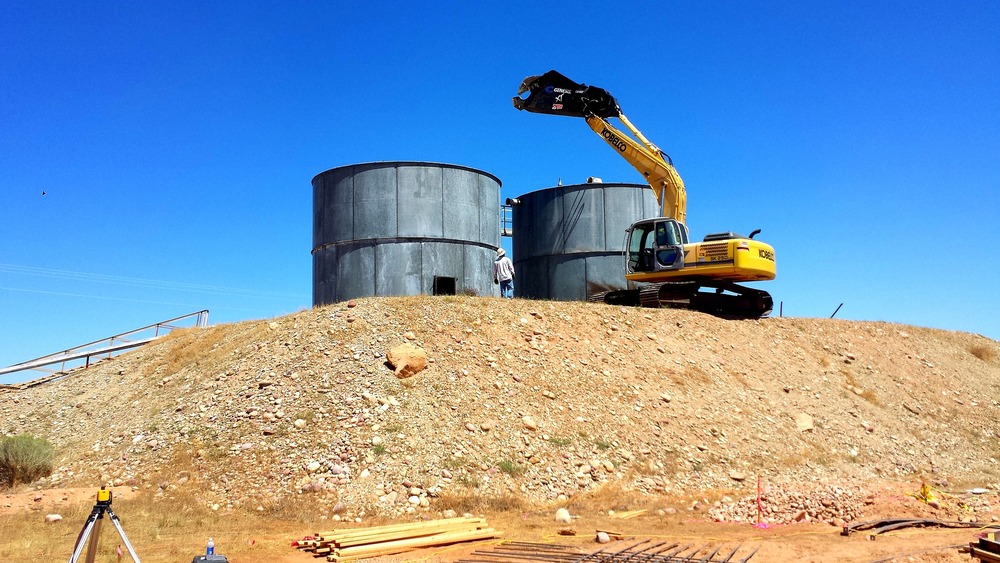If you work in the energy, agriculture, mining, water treatment, or industrial manufacturing fields, you’re well-acquainted with aboveground storage tanks (ASTs), as they are essential to your operations, for various storage and containment needs. ASTs hold fuel, water, fertilizer, food products, and more.
How Are Aboveground Storage Tanks Fabricated?
How are these important pieces of infrastructure constructed? Here’s what goes into the fabrication of an aboveground storage tank, from the beginning to the end of the process.
1. Design and Engineering
Storage tank engineering takes into account the unique needs of the application—the material to be contained, the required pressure and temperature, the storage duration, the types of containment needed, etc.—and the regulatory requirements to create a suitable tank design.
Some Common Tank Designs
- External floating roof tanks have a cylindrical shell and have a roof that is open, floating atop the fluid stored in it. These tanks are often used for petroleum and oil.
- Domed external floating roof tanks are very similar to typical external floating roof tanks but feature a roof that has a lighter domed structure.
- Internal floating roof tanks have a roof that is affixed to the tank shell, as well as a second, internal roof that floats atop the contained substance. These tanks are beneficial in extreme weather conditions.
- Fixed roof tanks have a domed or cone-shaped roof that is permanently attached to the shell. These are used mainly for water storage.
- Horizontal tanks are generally smaller and more portable than vertical ASTs and are designed to resist seepage.
- Pressure vessels are designed to contain pressurized substances and contain specialized pressure equipment such as vapor reservoirs.
- Variable vapor space tanks are spherical pressure vessels designed to maintain structural integrity under extremely high pressures.
2. Foundation
Aboveground storage tank foundations are crucial for ensuring the optimal performance of the tanks and preventing containment issues. The right foundation for a tank depends on factors such as the soil condition, environmental conditions, size of the tank, tank application, and containment needs. Some AST foundation types include:
- Concrete slab
- Pile-supported
- Concrete ring wall
- Crushed stone ring wall
- Wick drains with surcharging
- Stone columns
- Compacted soil
3. Fabrication
Aboveground storage tanks are generally fabricated in fabrication shops, workspaces designed especially to meet the space requirements of fabricating large metal components for tanks. Such a space will have several acres of laydown space, as well as heavy equipment like cranes and welders. Here, skilled technicians take the specifications from the design engineers and translate them into the components of the AST.
The material a storage tank is fabricated from is dependent on several factors, including the application, tank environment, and project budget. Some common tank materials include:
- Various grades of stainless steel
- Various grades of carbon steel
- Duplex stainless
4. Installation
Once an aboveground storage tank is fabricated and the site is prepared, it’s time for installation. This can be as simple as unloading the fully assembled AST onto the prepared foundation on the site (if the tank is small enough); it can also mean delivery of the tank components to the site, to be assembled on-location by an experienced installation crew (large ASTs).
5. Evaluation and Certification
Once a tank has been installed, it must be evaluated and certified before it can be put into use. Due to the nature of many substances stored in ASTs, which can be hazards to environmental or human health and are often valuable substances, critical to the operations of an organization, ensuring that the vessel is fit for service and meets all applicable standards and regulations is necessary before it can be put into service.
What Codes and Standards Apply to Aboveground Storage Tank Fabrication?
The primary standards that apply to AST fabrication are API 620 and API 650. API 650 pertains to tanks (of varying sizes) designed for withstanding higher temperatures at minimal pressure, and API 620 pertains to large, lower-temperature, pressurized storage tanks.
Other codes and regulations, such as the NBIC and ASME Boiler and Pressure Vessel Code inform the inspection, maintenance, and repairs of aboveground storage tanks and pressure vessels.
Contact PALA for Aboveground Storage Tank Fabrication
PALA Interstate has tank fabrication facilities in Baton Rouge and Hammond, Louisiana, that can accommodate your storage tank fabrication needs. We work with a variety of alloys, from stainless steel and titanium to Iconel and Haynes alloys, and we can fabricate storage tanks to meet API 650 and 620 standards.
If you have aboveground tanks in need of inspection, maintenance, or repair, PALA is also your source. We offer comprehensive tank maintenance programs, in-shop and on-site repair services, and even 3D Laser Scanning for tank analysis and inspection.

